Text
Khanda sword: The Double-Edged "Last Stand" Swing-Sword
Surrounded by a large number of enemy ground soldiers, and need a heavy, long, intimidating tool to get you out of trouble?
Meet the Khanda: An imposing, strong and simultaneously beautiful blade, dating back to third century India.

A Khanda Sword // Image Credit: Wikipedia
Khanda: Getting Out Of Trouble or Staging A Courageous "Last Stand"
The Khanda is widely believed to have been used in group situations -- especially in hand-to-hand combat when outnumbered -- to 'brute force' a way out of trouble, or when making a last stand. Its rather clunky design wasn't built for thrusting -- but rather for hacking, swinging and slicing, usually by unhorsed ground soldiers.
The blade starts off narrow at the base, and broadens heading up towards the point of the sword. Khandas are a double-edged weapon, however one side was usually sharper than the other, to allow the wielder to gently place a hand on one side (the not-so-sharp side!) to make it easier to manoeuvre. The point was generally blunt.
For hand protection, the hilt sports a large protective guard, with a wide area for gripping the sword hard with the fingers and wrists.
In military use, it was eventually replaced by other weapons due to not being very versatile in battle. However, its significance in religion and art lives on to this day.

Decorated Khanda Sword from the Sikh Museum // Image Credit: Sikh Museum
Khanda As An Art Form And Religious Symbol
In addition to its imposing weight, size and structure, many Khanda swords have also been discovered with ornate designs. on the blade and hilt. In many cases, the blades have been affixed with ornaments, decorations and designs; and in others, the hilt / hand-guards sport spikes, ornate designs, symbols and imagery.
Some statues with religious significance(many still standing today), also wield Khanda swords. Some believe that the Khanda helped deieties to 'cut through ignorance' on their way to enlightenment and superior knowledge.

Religious figure Mahakala wielding Khanda // Image Credit: Wikipedia
Ready to get your very own sword?
See our sword collection →
from BladesPro UK - Blog https://www.bladespro.co.uk/blogs/news/khanda-sword
0 notes
Text
Oda Nobunaga - The "Devil King"
Determined to unify Japan, a ruthless daimyo decided to gather his army and storm the infamous Inabayama Castle in Gifu. Known by many as the 'Devil King', Oda Nobunaga was a name many Japanese warriors feared across the continent. Learn how one of Japan's most influential leaders overcame a difficult childhood to become a respected warlord, courtesy of BladesPro.
Unique from Birth
Born into the prolific Oda clan, Nobunaga was the second son of the group's leader, Oda Nobuhide. Although he was the rightful heir to his father's throne, as a child, Nobunaga earned the nickname 'Owari no Outsuke', which translates to 'The Fool of Owari'. Many people thought of him as the black sheep of his family due to his odd behaviour and how he would hang around youths from different social rankings.
Claiming the Throne
Sadly for Nobunaga, his father Nobuhide died suddenly in 1551 and, the young heir was distraught. At the funeral, Nobunaga became so saddened by his father's death that he started throwing ceremonial incense and acting hysterical at the altar.
Nobunaga's reputation growing up and how he behaved at his father's funeral made several Oda clan members question whether he was ready to lead them, even though he was a legitimate heir. Angered by this succession crisis, Nobunaga rallied a thousand soldiers and ordered them to silence any members of his family that opposed him.
An image of Oda Nobunaga's battle armour. Image credit: Wikimedia Commons.
Even though Nobunaga was not afraid to flex his power, the young daimyo began having second thoughts about taking up his new role. Disgruntled by his decision, Hirate Masahide, Nobunaga's mentor, decided to commit seppuku to pressure him into leading the clan. Masahide's shocking death convinced Nobunaga to honour his position as the clan leader. Motivated by the loss of his mentor, Nobunaga overcame more attempts from his uncle and younger brothers to dethrone him and eradicated all rival Oda clan members by 1559.
Rise of the 'Devil King'
Once he solidified his spot as the undisputed leader of the Oda clan, Nobunaga got targeted by Imagawa Yoshimoto, a daimyo who wanted to claim a portion of his land. Vastly outnumbered 25,000 men to around 3,000, multiple of Nobunaga's advisors told him to perform a siege around their enemy's territory. Ignoring the advice he received, the daimyo decided to use a 'strong offensive policy' against Yoshimoto's large army.

On the battlefield, Oda Nobunaga wielded the intimidating Dojigiri Yasutsuna sword. Browse through our popular katana sword range to find the blade that suits you.
Later that year, a unit of Oda clan spies reported back to Nobunaga, telling him that the Imagawa army was rejoicing at a narrow gauge following their victory at the Washizu and Marune fortresses while Yoshimoto rested. Sensing an opportunity to launch a surprise attack, Nobunaga commanded his soldiers to create straw-men with spare helmets and mount flags at a nearby temple to deceive the Imagawa army into thinking they had more troops. After the decoys got placed, the Oda clan's army rushed around the back of the gauge to sneak attack Imagawa's men from behind.
During the ambush, a chilling thunderstorm closed in on the gauge causing the Imagawa army to seek shelter. Instead of taking cover themselves, Nobunaga continued his forceful approach and insisted that his men kept charging forward. Yoshimoto woke from his sleep after the surprise attack and began thinking his men were fighting among each other. He quickly realised this was not the case when two samurais from the Oda clan charged him with their weapons and killed him.
Following Yoshimoto's death, many of the Imagawa soldiers retreated or surrendered to Nobunaga. Emerging victorious from what is now known as the Battle of Okehazama helped Nobunaga gain respect from many samurais and warlords across the country.
A Fatal Betrayal
From 1568 to 1582, Nobunaga grew in power dramatically and became regarded for his attempts to unify Japan. After claiming most of Japan, Nobunaga started to plan an invasion of the Echigo Province and Shikoku. Before launching the campaigns, Nobunaga decided to visit the Honno-Ji temple in Kyoto to host a tea ceremony.
Since he was only visiting for recreational purposes, Nobunaga only brought 30 pages along with him and his son, Oda Nobutada, was accompanied by 2000 of his soldiers. Knowing that he was vulnerable, samurai Akechi Mitsuhide wanted to betray and assassinate Nobunaga for unknown reasons. Mitsuhide started his assassination attempt by misleading his army into Kyoto while pretending to follow the daimyo's orders. Instead, he commanded them to surround the Honno-Ji temple.

A statue made in honour of Oda Nobunaga at Kiyosu Park. Image credit: Wikimedia Commons.
Heavily outnumbered by Mitsuhide's men, Nobunaga instructed one of his page's, Mori Ranmaru, to burn down the temple while he committed seppuku so no one could decapitate his head. Ranmaru followed his master's wishes and, Nobunaga's remains never got discovered. Once he captured Honno-Ji, Mitsuhide also attacked the daimyo's son, Nobutada and forced him to commit suicide.
Years after his unexpected death, Nobunaga's legacy lived on through his trusted retainer and samurai, Toyotomi Hideyoshi, who avenged him and followed in his footsteps to become Japan's second 'Great Unifier'.
from BladesPro UK - Blog https://www.bladespro.co.uk/blogs/news/oda-nobunaga-the-devil-king
2 notes
·
View notes
Photo

Unberuto T10 Steel Katana Samurai Sword https://www.bladespro.co.uk/products/unberuto-t10-steel-katana-samurai-sword
1 note
·
View note
Photo

Hone T10 Clay Tempered Steel Tanto Sword https://www.bladespro.co.uk/products/hone-t10-clay-tempered-steel-tanto-sword
0 notes
Photo

Gurēsukēru Folded Steel Katana Samurai Sword https://www.bladespro.co.uk/products/guresukeru-folded-steel-katana-samurai-sword
0 notes
Photo

Zugaikotsu Carbon Steel Katana Samurai Sword https://www.bladespro.co.uk/products/zugaikotsu-carbon-steel-katana-samurai-sword
0 notes
Text
The Ultimate Push Dagger: The Katar of India
Originating in medieval India, the Katar is a push dagger used extensively against Islamic invaders, and later in other battles -- a formidable close-range weapon, which also became a status symbol.
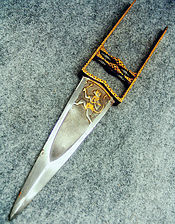
An Ornamental Katar with decorative design.
Image Credit: Wikipedia
A Menacing Tool -- With Built-In Protection
As well as a sharp, pointed knife edge, this dagger also contains built-in protection using a knuckle guard, which helped protect the hands in case of fierce opposition from an opposing fighter. That said, the knife contained little shielding from the side -- so the attacker needed to be swift enough to strike and then pull back. The katar's light weight and small size helped in this regard, as it allowed the wielder to strike quickly and smoothly.
It was used to attack in a thrusting motion at close range, but could also be used for slicing and thrashing if needed. Because of its short, wide design, the wielder can put their full body weight into a thrust.
The katar's blade is short (usually 30-90cm), wide and triangular, usually fashioned into a very strong point in order to pierce mail without breaking. (It's likely that only more slender-tipped blades were able to actually pierce armour in battle).

The uniqueness of the blade lies in its handle: a 'H'-shaped connection of parallel bars, connected to the blade. This resembles what may have been the inspiration: holding a knife between the index and middle finger. The guard was then added, partly for protection, and partly to make it much easier to wield and thrust.
Status Symbol And Depiction In The Noble Class
In addition to being a useful weapon in close combat, over time the Katar also became a symbol of nobility and high class, and Indian nobles were often depicted with a katar at their side.
Many adorned enamel, gems, special designs or gold foil to make them even more ornate and good-looking. The hilt was often sheathed in a fabric or velvet sheath (as India's hot climate made steel an unsuitable material for a sheath). They were often given as gifts or signs of respect between nobles and families.
Some swordsmiths also forged ceremonial katars, used for religious purposes as a method of worship.
The Katar was featured on the TV show "Forged In Fire":
youtube
Ready to find your own sword?
Browse our range >
from BladesPro UK - Blog https://www.bladespro.co.uk/blogs/news/the-ultimate-push-dagger-the-katar-of-india
0 notes
Text
The Roman Gladius: A Foot Soldier's Choice
Roman Weaponry: The Roman Gladius from the 1st - 3rd Centuries
A Foot Soldier's Weapon Of Choice
The Roman Gladius was a sword borne by the foot soldiers of Ancient Rome. Due to its size, it was particularly useful in very close combat situations - easy to wield, easy to thrust, easy to hold, and - most importantly - very lethal at close range.
Weighing around 1.5-2 pounds, the sword was relatively light by many swords' standards, making it easy to carry for both stronger soldiers and those called up to fight at short notice. Its double edge also made it versatile, and effective in cutting, slashing and thrusting in a stabbing motion.
Image credit: Wikipedia
Meaning and Discovery
Meaning "Sword" in Latin, the Gladius was developed to be used in close proximity and became popular among the armed forces in around the 3rd centre BC. From ancient artworks such as wall paintings, engravings on tombs as well as mosaics found at ancient sites, it's likely that the Gladius was sheathed in a scabbard made of metal or wood, and hung from a belt for easy access.
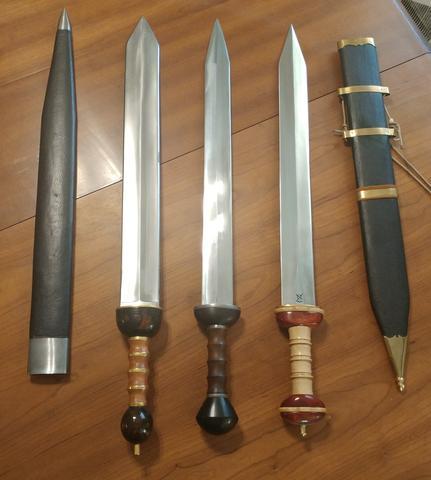
Some modern day recreations of the Roman Gladius
Gladius Variations
It's believed there were several types of Gladius in circulation:
Gladius Hispaniensis
The Gladius Hispaniensis ("Hispanic Sword"), the longest of the variations at around 27 inches. Also the heaviest and earliest variation.
Mainz Gladius
Shorter at around 21 inches in length, this variant was made of tinned and gilded bronze, and had more of a triangular point than its predecessor.
Fulham Gladius
Widely used until the end of the 1st century BC, it had a triangular tip and was similar in size to the Mainz Gladius, at around 22 inches. It's named for a replica housed at Fulham Palace, Fulham.
Pompeii Gladius
Named after the town of Pompeii, this was the most popular Gladius and four were found in the town itself. This was the shortest of the 4 known variants at around 20 inches long.

Image Credit: By Didymus Ridgeland - Own work, CC BY-SA 4.0, https://commons.wikimedia.org/w/index.php?curid=77692242
Modern Day
These days, many different styles of the Gladius sword can be found online in different designs, but still modeled after the same shape and approximate dimensions as those thought to be used by the ancient Romans. The gladius has also been featured in many works of fiction related to ancient Roman battles. Some replicas are housed at museums around the world.
Get Your Own Sword
Looking to acquire your own sword, for decoration, training or a gift? See our wide range of swords here.
SHOP SWORDS
from BladesPro UK - Blog https://www.bladespro.co.uk/blogs/news/roman-gladius
0 notes
Photo

Nachuraru High Carbon Steel Sword Set https://www.bladespro.co.uk/products/nachuraru-high-carbon-steel-sword-set
0 notes
Photo
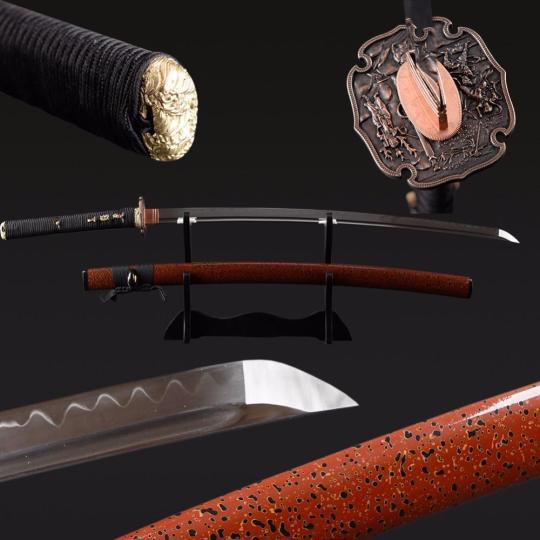
Aat Clay Tempered Folded Steel Katana Samurai Sword https://www.bladespro.co.uk/products/aat-folded-clay-tempered-steel-katana-samurai-sword
0 notes
Photo
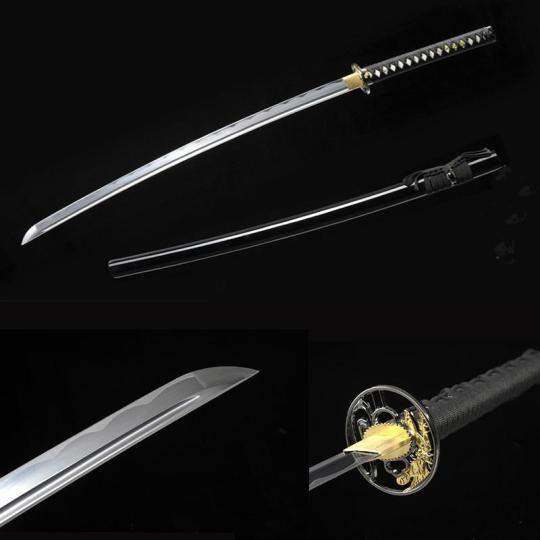
Aaiwa Katana Samurai Sword https://www.bladespro.co.uk/products/aaiwa-katana-samurai-sword
0 notes
Photo
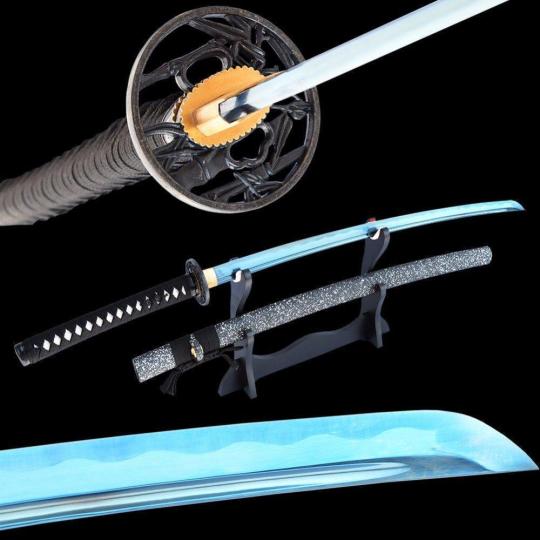
Fudo High Carbon Steel Katana Samurai Sword https://www.bladespro.co.uk/products/fudo-high-carbon-steel-katana-samurai-sword
0 notes
Photo
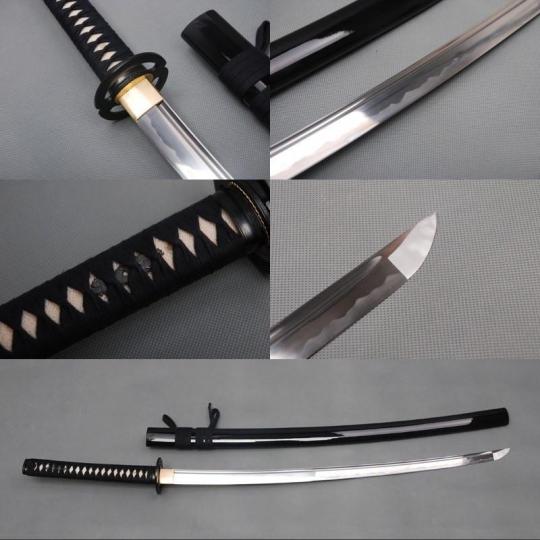
Tashi Carbon Steel Katana Samurai Sword https://www.bladespro.co.uk/products/tashi-carbon-steel-katana-samurai-sword
0 notes
Photo

Artemis Carbon Steel Katana Samurai Sword https://www.bladespro.co.uk/products/artemis-carbon-steel-katana-samurai-sword
0 notes
Photo

Akihiko Carbon Steel Katana Samurai Sword https://www.bladespro.co.uk/products/akihiko-katana-samurai-sword
0 notes
Photo

Amida Carbon Steel Katana Samurai Sword https://www.bladespro.co.uk/products/amida-katana-samurai-sword
0 notes
Photo

Akio Carbon Steel Katana Samurai Sword https://www.bladespro.co.uk/products/akio-katana-samurai-sword
0 notes